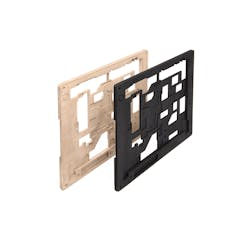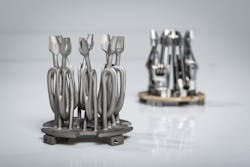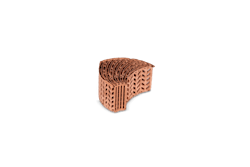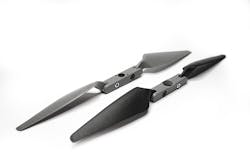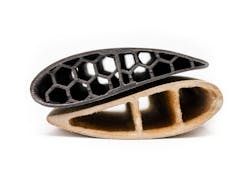The evolution of 3D printing and additive manufacturing
By Jim Romeo
3D printing and additive manufacturing are disrupting many industries, including military aviation, electronics, and the broader defense industry as its use continues in many ways.
3D printing eases prototyping by enabling engineers to prototype parts, components, and other forms rapidly to expedite development. It also may help produce tools and jigs for maintenance, assembly, and fabrication of parts and systems. It also may be used for actual production of parts by providing users a unique self-sufficiency to produce parts and forms that would otherwise have a long lead time, be costly to acquire, and impose risk of the part not working well or being useful.
Whereas a 3D printed part may be produced in rapid time, it allows for the experimentation of printing a part with various types of materials, and may produce parts and components in-house, without relying on costly and time-consuming production contracts.
Jeff DeGrange is the chief commercial officer at Impossible Objects Inc., a composite 3D printing company in Chicago. He views 3D printing as an advantageousAdd to the increased production capability of additive manufacturing, other technologies such as artificial intelligence (AI) and advanced printing techniques, and many more things are possible. Douglas Krone is the CEO of Dynamism Inc., a global supplier of next-generation 3D printing technology in Chicago. Krone has specific expertise in military, warfare, aeronautical, and space operations.
He notes that 3D printers have increased capability stemming from advances in AI, precision, repeatability, and LED technology. Dynamism uses resin-based 3D printers to drive advances in panel resolution. He says such innovations enable 3D printers to deposit more energy, faster and at a given point. This allows faster printing and opens the capability to print in more advanced materials with a cost reduction in many ways.
"Military units can print replacement parts or equipment directly in the field or on naval vessels, reducing the need to carry large inventories of spare parts and allowing for faster repairs," Krone says. “Ships at sea increasingly use 3D printers for temporary replacement parts, vastly reducing the number of spare parts that need to be carried on board.”
Ian Ferguson is the vice president of marketing at Lynx Software Technologies in San Jose, Calif. He notes the value of 3D printing in conserving time and schedule in producing parts and forms.
“Thinking big picture, I think the main challenge in this sector is decreasing time-to-system deployment," Ferguson says. "With the headwinds of additional system complexity, supply chain, and hiring challenges, this is critical, and challenging. In this context, 3D printing is helping pilots familiarize themselves with new cockpit layouts significantly faster than would have previously been the case. At least in our area of the industry, this has been the impact we have seen so far."
3D printing for defense
Krone adds that 3D printing fabricates parts with favorable characteristics, which often is necessary in defense applications. "The landscape is shifting towards smaller, more cost-effective platforms such as autonomous drones with differing levels of capabilities," he says. "For systems that don’t need to fly for thousands of hours, there are opportunities to combine the most cost-effective electronics and physical enclosures that create a 'good enough' categorization."
These systems, Krone explains, must be securely connected with other intelligent platforms for effective coordination of missions, and this leads to all sorts of new challenges related to cyber security. Competition is a great catalyst for innovation, and we believe that this will cause the traditional suppliers to respond with new approaches on delivering traditional materials, coupled with advanced modeling solutions, to support the overall theme of improved time to market."
Additive manufacturing, with a myriad of materials selections, opens new possibilities for sourcing. Donald Gough is the senior manager of advanced manufacturing technology for Lockheed Martin Corp. in Orlando, Fla. He says 3D printing also can enable new capabilities.
"Additive manufacturing provides a new capability to help tackle the increasing complexity and affordability demands of the next generation of aerospace and defense products," Gough explains. "While not without challenges, the benefits of 3D printing electronics extend beyond manufacturing methods by enabling new materials, design trades and sourcing strategies. This emerging market offers opportunities to streamline development cycle with rapid prototyping, enhance performance of new products with design for additive methodologies, and enable increased scalability in manufacturing."
Gough points out that this opens up more possibilities and opportunities that otherwise would be constrained by the limitations of legacy manufacturing methods and processes.
"The use of 3D printed hardware continues to increase because it provides engineers with more latitude to explore new design trades without the traditional limitations from legacy manufacturing processes," Gough says. "Rapid development cycles, advanced packaging concepts, and the ability to increase componentAnother potential benefit of 3D printing is quality assurance. Kerim Genc is a product manager at design automation company Synopsys Inc. in Mountain View, Calif. He says that despite the many obvious advantages of 3D printing, experts still are trying to iron-out some of the quality quirks in its use.
"Although there has been significant investment in additive manufacturing, there is still a lot of uncertainty around build quality, especially for load bearing parts," Genc says. "The industry is still developing the proper techniques for quality assurance and has even more work ahead to scale these techniques to production levels."
The next few years, he adds, will see a slow transition to a more inward-looking industry, where quality and scalability are a bigger focus. "With this, we will see more and more critical components come to market via additive manufacturing. As research groups within government labs and industry figure out the best applications for additive manufacturing where the quality assurance is consistent and meets the required regulatory standards, they will be able to scale."
Form follows function
When it comes to 3D printing, its versatility validates the expression “form follows function.” Mike Shepard is the vice president of aerospace and defense for 3D Systems Corp. in Rock Hill, S.C. He says additive manufacturing best enables form to follow function in developing designs for parts and components.
"New defense platforms are always looking for technology that can improve performance; 3D printing is an ideal tool for that," Shepard says. "It really unlocks your ability to manufacture complex and creative designs. Now, with many of the limitations of conventional manufacturing relaxed, components can be more closely tailored to suit the physics of the application. Form can closely follow function. An excellent example of this is what we see happening with 3D printing in electronics. We don’t do direct printing of electronics commercially, but for us, we see tremendous activity in 3D printing to remove heat from electronics - heat sinks, heat pipes, and heat exchangers."
"It has been so much fun to see what creative designers are doing with metal additive manufacturing for heat transfer," Shepard says. "In fact, we’ve had so many partners coming to our Application Innovation Group (AIG) to consult on heat transfer, that we’ve added some additional copper alloys to our materials portfolio. We’ve added pure copper, which is excellent for thermal conductivity, and the CuCr2.4 copper alloy, which still has very good thermal conductivity and added strength for added strength and durability.
"The heat exchangers that we can print on our direct metal printing (DMP) systems are remarkable, and because of our low oxygen printing environment (<25PPM O2), the parts come out of the printers with an excellent surface finish," Shepard continues. "The metal has little to no additional oxygen pickup during printing, preserving conductivity. The low oxygen levels in our systems also let you reuse the powder to exhaustion."
Shepard says that using the design freedom you have with the direct metal printing process and the materials we have in the toolkit, you can move much more heat for a given volume/weight in the use case of the heat exchanger. "Increases can be on the order of hundreds of percent," Shepard says. "Oqton [a company that offers manufacturing software solutions for additive manufacturing applications] is even adding dedicated heat exchanger design tools to its 3DXpert software that we use for metal additive manufacturing to help designers get the most out of laser powder bed fusion on our systems as well as other systems on the market."
Looking ahead
Heather Wickman is a manager at BAE Systems Electronic Systems in Nashua, N.H. She is the company's defense materials engineering capability group lead, and says the future potential for additive manufacturing is tremendous.
"Additive manufacturing, though it is not new, is nowhere near fully mature and thus, has great growth potential of new materials in polymers and metals," Wickman says. "Polymer improvements that will displace the use of metal for certain applications. The evolution of metals will continue to yield more “tailorableThe potential benefits for electronics applications will range from maturing the fidelity and complexity of circuit cards, direct write metal and dielectric traces, antennas in addition to playing a significant role in heterogeneous integration, Wickman says.
She also notes that additive manufacturing is still in a growth and adoption phase, there are still some hurdles to cross. "Additive manufacturing is like any technology that is maturing in its application and has the hurdles of validation and qualification which, is not trivial and with the aerospace and defense qualification requirements," she says. "However, challenging these hurdles may be worth the investment. It’s clear that additive manufacturing is wrought with opportunities for the industry and when applied judiciously can yield systems that accommodate the ever-increasing sophistication and demands of technology, like electronic warfare, that can facilitate a platform’s overall performance."
William Downing is a design engineer for the Weapons System Test Engineering Branch of the Integrated Engagement Systems Department at Naval Surface Warfare Center Dahlgren Division in Dahlgren, Va. "One of our technologies, additive manufacturing, is a great tool when used properly with conventional machine processes. You need to use a slightly different way of thinking and design process to get the most out of additive manufacturing. Printed scaled down models can make a positive impact in meetings and presentations. It is helpful to actually see a part and be able to point out and see all the features."
The great thing about 3D printing is that it is always about inventing and moving forward, says Mark Menninger, director of U.S. government business, for 3D printer manufacturer Stratasys Ltd. in Rehovot, Israel. "Whether you are talking about new hardware, software or materials, there is a huge opportunity to take additive manufacturing to new levels. Beyond that, additive manufacturing will take on new heights when it comes to mass production, making additive manufacturing even more common."
Department of Defense 3D printing and additive manufacturing strategy
The U.S. Department of Defense (DOD) is bullish on the future of 3D printing and its value to defense applications. DOD leaders have unveiled an additive manufacturing strategy to bolster warfighter readiness and secure a competitive edge in military operations.
The strategy serves as a roadmap for the adoption of additive manufacturing technology within the DOD, pinpointing key areas that require development and investment. The strategy document, Department of Defense Additive Manufacturing Strategy, is online at https://www.cto.mil/dod-additive-manufacturing-strategy/.
Recognizing additive manufacturing as a critical capability for maintaining technological superiority on the battlefield, the DOD highlights its potential to facilitateTo harness the potential of additive manufacturing, the DOD's strategy encompasses several crucial focal points:
1. Strengthening the additive manufacturing workforce and infrastructure within the DOD. Acknowledging the need for a highly skilled workforce capable of designing, producing, and maintaining additive manufacturing systems, the strategy calls for increased investment in educational and training programs. Additionally, the development of additive manufacturing-centric facilities and infrastructure is deemed essential.
2. Establishing standards and specifications for additive manufacturing materials and processes. Ensuring the quality and consistency of additive manufacturing-produced parts and components is a priority for the DOD. Consequently, efforts are underway to establish industry standards and specifications for additive manufacturing materials and processes, enabling interoperability across various additive manufacturing systems while ensuring the reliability and safety of additive manufacturing-produced components.
3. Investing in additive manufacturing research and development. The DOD plans to allocate resources to additive manufacturing research and development initiatives, aiming to advance the state of the art in additive manufacturing technology. This encompasses the exploration of new additive manufacturing materials, processes, and systems, as well as the discovery of novel applications for additive manufacturing technology.
4. Integrating additive manufacturing technology into DOD supply chains. The DOD aims to seamlessly integrate additive manufacturing technology into its existing supply chains, empowering the rapid production of critical parts and components in the field. By doing so, the burden of maintaining a substantial spare parts inventory will be alleviated, while the DOD gains the agility necessary to respond swiftly to emerging threats and operational requirements.
The strategy further outlines specific initiatives that the DOD intends to pursue as part of its additive manufacturing adoption efforts. These include:
5. Establishment of an additive manufacturing community of interest (COI) to foster collaboration and information sharing among DOD stakeholders involved in additive manufacturing.
6. Investment in additive manufacturing-centric infrastructure, encompassing the creation of additive manufacturing centers of excellence and the development of additive manufacturing-centric software and data systems.
7. Development of additive manufacturing-specific certification programs to ensure that DOD personnel involved in additive manufacturing operations possess the requisite training and qualifications.
8. Formation of partnerships with industry, academia, and other government agencies, thereby leveraging their expertise and resources in the realm of additive manufacturing technology.
The DOD's additive manufacturing strategy represents a significant stride forward in the military's embrace of advanced manufacturing technologies. By embracing additive manufacturing, the DOD seeks to enhance its readiness and agility on the battlefield, while concurrently bolstering its competitiveness and technological advantage. Supported by industry, academia, and other government entities, the DOD is poised to assume a leadership role in the development and adoption of additive manufacturing technology, guaranteeing that the military remains at the vanguard of technological innovation and excellence.
Additive manufacturing and 3D printing at Northrop Grumman
Northrop Grumman Corp. is leveraging 3D printing to innovate and enhance its products and services. The company has been using this technology for more than two decades to produce parts and components for aircraft, satellites, and other systems.
Northrop Grumman also has invested more than $70 million in additive manufacturing, and has integrated more than 5,000 additive manufactured parts into their aeronautical platforms, all sourced from small- and medium-sized suppliers. Additionally, the company collaborates with universities and colleges. A notable additive manufacturing process they employ is direct metal laser sintering, which utilizes a laser to melt powdered metal and create complex parts.
One notable example of their advancements in additive manufacturing (additive manufacturing) has been applied space applications. Specifically, they were involved in NASA's Artemis I mission, where they designed twin solid rocket boosters for the Space Launch System (SLS) rocket.
In 2020, Northrop Grumman transported 10 rocket motor segments from Promontory, Utah, to the Kennedy Space Center. At the center, these motor segments were assembled into two separate solid rocket boosters. The assembly process of these boosters incorporated 3D printing and computer modeling. These technologies were utilized to modify existing component designs from the shuttle program and create new components that are compatible with the existing assembly processes.
They use a variety of additive manufacturing processes, including powder bed fusion, directed energy deposition, and polymer 3D printing. The company also has developed its own proprietary processes and materials to meet specific requirements and applications.
Like many other engineering and technology companies, they are putting additive manufacturing to work to enhance engineering and design processes. The company uses 3D printing to produce prototypes and models of its products, enabling quick design iterations and more efficient testing.

